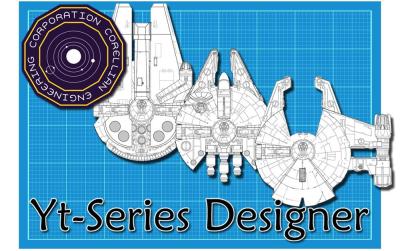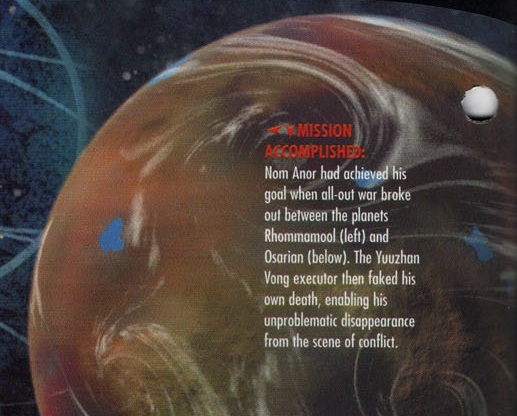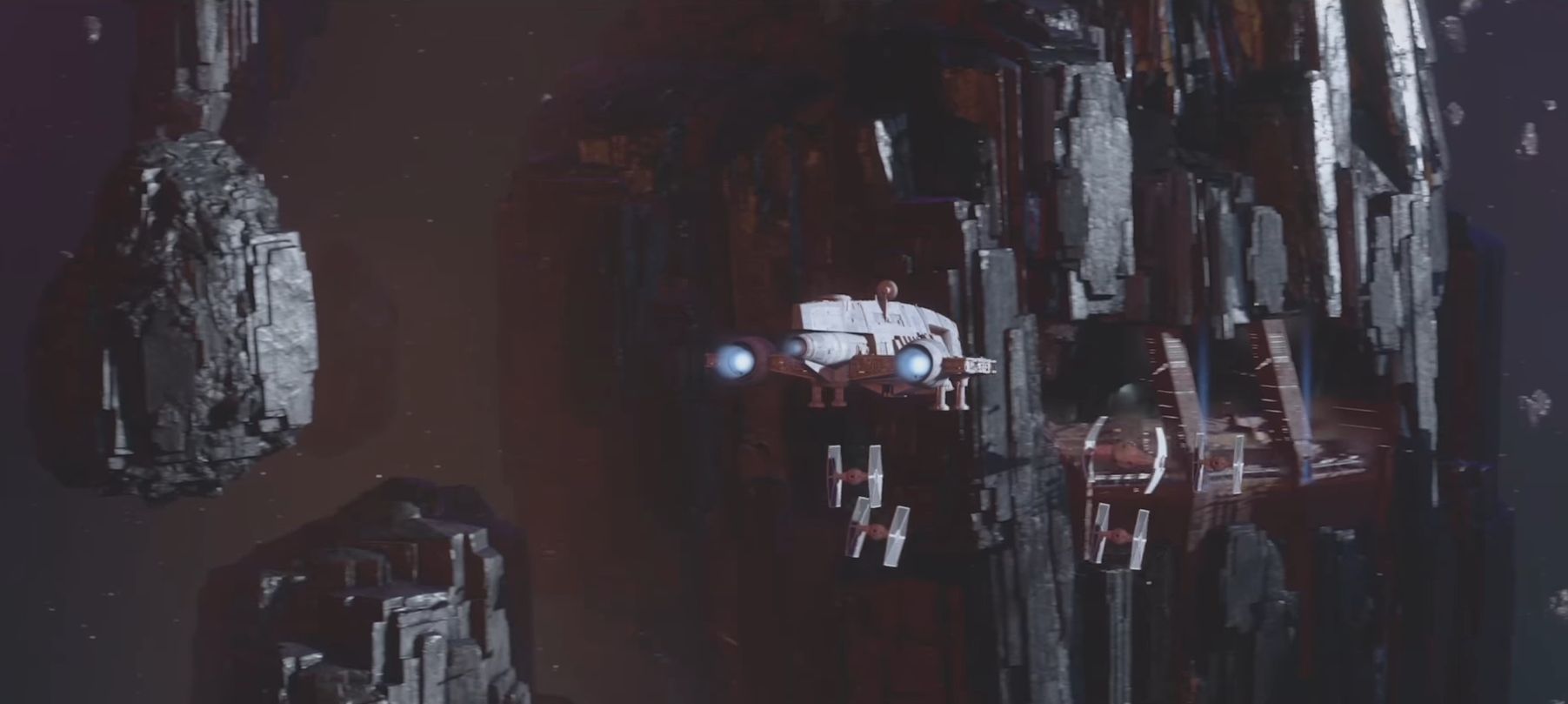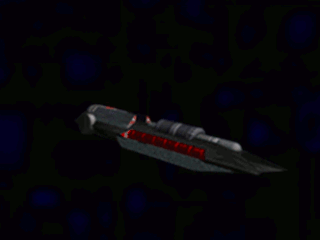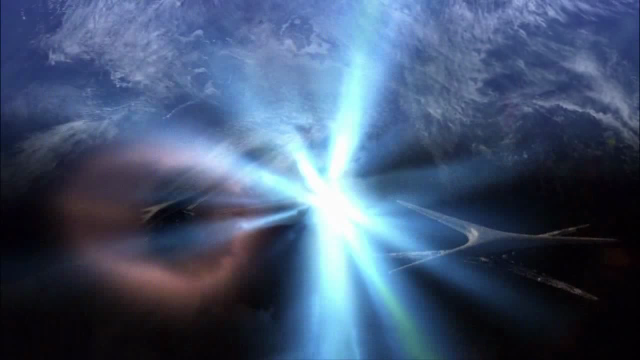 FTL JUMP DRIVES
In the newer series of Battlestar Galactica, ships travel faster than light (FTL) to get to other star systems, and beyond, using FTL jump drives. These allow starships to cross distances that would never have been possible with their normal sublight propulsion. However, where the Hyperdrive in Star Wars still takes time to traverse these interstellar distances, the FTL drives of BSG instead appear to be near-instantaneous. Ships using these drives disappear in a bright burst of light to almost instantly reappear elsewhere (but not always where they expected to be).
The information directly below relates to the game effects of BSG FTL Drives using the WEG D6 Star Wars RPG rules. After the Game Notes section, there is much more detailed information on the FTL drives, which would enhance the role playing aspect of a BSG game, or any game using these FTL drives.
Model:
-Colonial FTL Drive
-Cylon FTL Drive
Type: Faster than light propulsion unit
Cost:
-FTL Drive:
*Starfighter: Hull Dice x1,000 credits (pips x300)
*Capital: Hull Dice x5,000 credits (pips x1,000)
-Colonial Nav Computer (Civilian type): 1/4 above cost
-Colonial Nav Computer (Galactica type): 1/2 above cost
-Colonial Nav Computer (Pegasus type): 3/4 above cost
-Cylon Navigation Computer: x1+1/2 above cost
Skill: Astrogation
Availability: 2, F
Game Notes:
All FTL drives function about the same, but the navigational systems used for plotting courses are what determine the drive's efficiency and available range before reaching the "Red Line".
-Colonial Navigation Computers: The Twelve Colonies have used two kinds of nav computers, the modern type used in ships such as the Pegasus and most common vessels expected to reach other star systems, and that used in the Galactica and other battlestars and military craft from the original Cylon War. The Pegasus type of modern FTL nav computer functions just as Nav Computers in Star Wars RPG, with the same Difficulties involved in plotting courses. The type used aboard the Galactica was not as advanced as the modern type, as the computer systems used to operate these ships were not networked together in order to avoid Cylon wireless electronic attacks. Because of this, these nav computers require their courses to prepared at +1 to the Difficulty involved. The Galactica's crew were highly skilled in plotting these courses constantly as they fleed from the Cylons. If the crew of such ships as the Galactica ever need to make things easier, they can always network the computers to lessen the Difficulty by -1 (to normal), but this will leave the systems open to Cylon electronic attacks. Even if the course is correctly plotted and executed before the Cylons gain control of the ship, viruses could be left in the systems that would cause trouble later.
-Cylon Navigational Computers: The Cylons FTL technology is much more advanced than that of the Colonials. Any ship equipped with a Cylon nav computer makes their Astrogation rolls at -1 Level of the normal Difficulties needed for doing so.
-Range and Speed: Where hyperdrives in Star Wars RPG and related fiction give their means of FTL varying speeds, the FTL drives of Battlestar Galactica differ greatly from this. The further the destination for an FTL jump, the harder it is to calculate with the Astrogation skill. While the exact distances for FTL drives and their nav computers isn't specified (see below), the general ratio is that whatever max distance a Cylon ship could make, the Galactica would have to make three times (x3) the jumps to cover the same distance (before her and the Fleet are later upgraded with Cylon FTL technologies). Galactica is stated as having better FTL navigation ability as the Fleet, and usually calculates the Fleet's next jump, relaying this data to every ship so the Fleet jumps together safely (that way, wherever they wind up, they will be together). Otherwise, Civilian ship's nav systems must cover these distances at x5 their Cylon equivalent! The Pegasus, having more advanced technology installed, covers FTL distances at x2 their Cylon equal. So, all of that said...
FTL DRIVE RANGE/SPEED:
-Cylon: x1
-Colonial (Modern Military): x2 (Pegasus type)
-Colonial (War era): x3
-Colonial (Civilian): x5
------------------------------
FURTHER INFORMATION
FTL is an abbreviation for Faster-Than-Light. The term refers to a means of interstellar propulsion utilized by the Cylons and the Colonials. A common shorthand term for FTL travel is "jumping", as this space-folding drive involves making instantaneous "jumps" across vast distances in space.
The FTL drive makes interstellar travel possible for both the Colonials and Cylons. No longer confined to their own home solar system, the Cylons managed to avoid Colonial interference for 40 years after the Cylon War and establish their own home-world. However, not all ships ? from small to large ? are outfitted with these drives (Miniseries).
It is likely that FTL drives are not commonplace on many civilian ships because of the costs involved in using and maintaining the drive and the amount of fuel available. For some civilian ships that travel comparatively short distances between some destinations, such as the ill-fated Botanical Cruiser (Miniseries), FTL may simply be impractical or unnecessary.
The technology behind FTL systems is such that, providing the relevant data is known (how that data is acquired, for instance how ships can determine what obstacles are present at their destination, despite never having traveled there before, is not known) ships can jump with a high degree of accuracy, allowing ships to rendezvous in space and even "park" in a synchronous orbit directly above a given point on a planet's surface (Miniseries). Proper FTL use even enables vessels to arrive in crowded areas, such as the middle of an asteroid field or other ships, without the risk of collision and damage (The Hand of God).
Little specific information on the technology of an FTL drive has been given in the Miniseries or regular series. We know only that Galactica has two FTL drives[2], and that other smaller or civilian ships have a single drive. Ships also do not need to be in motion for the FTL drive to work, or at least smaller craft do not need to be, as Raptors during the Battle of the Colony jump directly from Galactica's starboard flight pod without engaging in forward momentum.
FTL drives on Galactica are said to be "spun up" in preparation for a jump, contain components such as the "spinner" ("The Captain's Hand") and "spin-sync generator" ("Faith") and display a rotational and possibly electromagnetic operation. Until the final-season episode, "Blood on the Scales", the expression was theorised by many fans to be either a turn of phrase, or an anachronism dating back to another form of propulsion, much like the use of the term "air" in reference to fighter operations in the vacuum of space ("Commander Air Group", "Combat Air Patrol", inter alia) and the real-world use of "sail" and "set sail" in reference to self-propelled vessels.
An operational FTL drive was first seen in "Blood on the Scales", specifically one of Galactica's two. Indeed, an assortment of long, thick shafts spin as part of the FTL drive mechanism. The FTL engine room includes a control terminal for diagnostic and auxilliary control. In order to prevent Felix Gaeta and his mutineers from jumping Galactica to an unknown location, former Senior Chief Petty Officer Galen Tyrol attempted to log into the engine room terminal which refused him access, recognising his duty status as "inactive". He was nevertheless able to manually disable the drive by removing a synchronisation coil. Gaeta made no attempt to use the other FTL drive, indicating either that the other drive was inoperative, the two drives are not entirely independent, that neither drive alone is sufficient to jump the ship, or that Gaeta simply decided that the mutiny and Coup d'?tat were doomed and futher attempts were pointless.
FTL jump drives can be used within an atmosphere. This Colonial tactic is used often to evade Cylon detection. While Raptors primarily perform these kind of jumps, Admiral William Adama performs a daring intra-atmosphere jump at approximately 100,000 feet altitude with Galactica during the Battle of New Caprica to evade immediate Cylon detection. The battlestar jumps back to space a few thousand feet above the planet's surface after its Viper deployment. When Galactica jumps, the clouds surrounding it and the re-entry fires consuming its hull are "sucked" into the vacuum created by the sudden loss of volume. A clap of thunder is heard afterward, likely caused by air rushing into the aforementioned vacuum (Exodus, Part II). A similar phenomenon occurs when Pegasus jumps from the attack on the Scorpion Fleet Shipyards; the resulting displacement not only draws in the burning gases from the nearby berthing superstructure, but also defuses two nuclear warheads bound for Pegasus itself (Razor).
An area of spatial distortion of some sort is also produced when a ship jumps. This effect has been observed twice thus far. Once, when the tylium refinery ship Hitei Kan is approached by a pair of Vipers and a Raptor in an effort to quell a mutiny aboard the ship. The Hitei Kan unexpectedly jumps and the Vipers and Raptor are repelled away by some force as soon as the ship dematerializes (A Disquiet Follows My Soul). The second time this is seen is when a Raptor stolen by Sharon "Boomer" Valerii executes a jump mere meters away from Galactica?s hull. When the Raptor disappears into the jump the section of the hull it was adjacent to is instantaneously indented. Just prior to that, Col. Saul Tigh expresses his fears of even greater damage should Valerii jump the Raptor while inside Galactica?s flight pod (Someone to Watch Over Me). During the Battle of the Colony, several Raptors actually do jump from within Galactica?s sealed off starboard flight pod causing significant damage to the landing bay within the pod and most likely contributed to the catastrophic failure of her hull after the battle (Daybreak, Part II). It is not clear how this distortion field, which seems to produce effects like a shock wave, also coincides with the known effect of a jump acting as a sort of vacuum, which instead of producing an outwards wave should pull the surrounding space into it. The two effects might occur consecutively, the vacuum effect left in the ship's wake, then the expelled shock wave, as hangar equipment in the flight pod is seen being pulled towards the vacuum before being expelled outwards.
Later, the Fleet's FTL drives are upgraded by the Rebel Cylons so they can now travel as far and as fast as a Cylon ship. Not all ships are apparently upgraded as for some reason, the Raptor Boomer steals lacks the upgraded drive.
LIMITATIONS OF COLONIAL FTL
-The effectiveness of a Raptor's FTL is limited to brief, short-distance jumps. Raptors require a sequence of short consecutive FTL "hops" to reach the same destination as a Colonial capital ship with a full-sized FTL drive (Miniseries).
-Colonial FTL systems are prone to breakdown after repetitive use over an extended period of time (33).
-Colonial FTL systems appear to be a holdover from the Exodus from Kobol, and their current designs have been developed to meet the needs of jumping between the Twelve Colonies, and their outposts in other star systems. Colonial FTL capabilities are generally limited in effective range compared to Cylon FTL.
-Colonial FTL computers are prone to glitching, often jumping ships to the wrong coordinates (Lay Down Your Burdens, Part I).
-Navigators must be careful to plan FTL jump paths in order to keep a safe distance from planets or other large objects (Kobol's Last Gleaming, Part I).
-"Spooling up" a Colonial FTL drive takes at least 20 minutes (200 combat rounds!) when the drive has been offline (Crossroads Part II). Because of this, when ships enter dangerous situations, they keep their FTL drives "spun up". Drives cannot be kept spun up indefinitely, as system crashes or serious damage to the drive will occur. A "cooldown" time is required after a jump for new jump calculations, so a ship that has jumped into a new location cannot jump to another location for a brief period of time.
-Colonial capital ships (at least older ones of the Galactica type) require the flight pods to retract before a jump, prolonging jump prep time. Should the ship jump with extended pods, serious structural damage can occur (Damage equals the ship's Hull Dice, per jump made this way).
Colonial FTL performance can be improved, demonstrated when a Raptor is successfully refitted by a team apparently led by Lieutenant Felix Gaeta with the navigational computer from a captured Heavy Raider (presumably the one used by Kara Thrace to return from Caprica in "Home, Part I") and, with the cooperation of a Number Eight, is used to navigate a squadron of Raptors back to Caprica on a rescue mission to retrieve a group of resistance fighters (Lay Down Your Burdens, Part I). A massive distance that would have taken Galactica 241 jumps one way (~482 jumps total), the Raptor squadron does in only 20 (10 to Caprica, 10 back).
Colonial FTL computers can be affected by highly-charged sub-atomic particles, corrupting their calculations and possibly causing a jump beyond the Red Line, as in the case of Raptor 718 (The Face of the Enemy, Episode 2).
The FTL drive apparently puts significant strain on a ship's structure. Galactica has substantial cracks in her hull adjacent to the FTL drive which Tyrol disabled. (Blood on the Scales) While discussing structural repairs with Adm. Adama, Tyrol asks him not to jump the ship for a while, whilst his crews upgrade the structure. (No Exit)
FTL jumps can apparently induce nausea or discomfort in some people, such as Cally Henderson (Miniseries, Night 2, "Kobol's Last Gleaming, Part I").
CYLON ADVANTAGES IN FTL
-Cylon FTL systems can be manufactured on a smaller scale to their Colonial equivalent, thus allowing the Cylon Raider to be outfitted with an FTL drive. (Miniseries).
-Cylon FTL drive systems are far more efficient than their Colonial equivalent. Tests with the Raider captured by the Battlestar Galactica (You Can't Go Home Again) demonstrated that the drive could enable the Raider to jump directly from the vicinity of Kobol back to Caprica (Kobol's Last Gleaming, Part I) - a jump completed by Lieutenant Kara Thrace during her search for the Arrow of Apollo (Kobol's Last Gleaming, Part II). This superiority is not from FTL drives themselves, but from the superior Cylon navigation system, resulting in more accurate jump calculations.
Cylon FTL drives are?using the most conservative estimation?three times more effiicent than their Colonial counterparts (A Disquiet Follows My Soul). Despite being well-versed in maintaining Galactica's two FTL drives and being a Final Five Cylon, former Senior Chief Petty Officer Galen Tyrol is baffled by Cylon FTL technology and defers to "Sixes, Sharons and maybe even some Leobens" to upgrade Colonial ships' drives. The Fleet later gets the upgrade and the difference can be clearly seen in the jump capabilities: a Raptor stolen by Boomer which for an unknown reason doesn't have the upgraded drive, takes over a dozen jumps to reach The Colony, but Galactica and even an upgraded Raptor are able to make the distance that took that Raptor over a dozen jumps, they make in one.
The Cylons may also be capable of faster-than-light communication.
FTL JUMP RANGES
The range that Galactica can jump at has never been specified on-screen. However, in a deleted line from the mini-series the jump from Ragnar to the Prolmar Sector is said to be "30 light-years", which is way beyond the red line (maximum safely calculable jump range). This is consistent with Colonel Tigh saying that Galactica could search every planet within 12 light-years for water before having to jump to another sector altogether (Water). On this Wiki, producer Bradley Thompson suggested that internally, the writers had been working on the idea the Fleet had been jumping about 5 light-years at a time, although that does not have to have been its maximum range. Finally, on composer Bear McCreary's blog, science advisor Kevin Grazier and producer Bradley Thompson suggested that the final six digits for the jump coordinates Kara interprets from the Music represent distance in SUs. 999,999 SUs - the maximum possible distance that can be inputted - would relate to 15.812 Colonial light-years. The distance inputted during the Battle of the Colony is 365,321 SU or 5.77 Colonial light-years, which is presumably the distance from the Colony to Earth (Daybreak, Part II). There may also be a factoring scale at work, and at close ranges Galactica appears to be able to jump much more accurately, as demonstrated by its jump from several million kilometers directly into New Caprica's atmosphere 100,000 feet above the surface (Exodus, Part II), or a jump of unknown range to within one kilometer of the Colony's surface (Daybreak, Part II), though this was more likely done with Raptors doing recon before these jumps were made, collecting the needed data for the Galactica to make these jumps more accurately.
Cylon FTL ranges are considerably larger. At the end of the series, the Fleet's larger ships have their jump ranges tripled by the installation of Cylon technology (A Disquiet Follows My Soul). However, during the rescue of Colonial resistance forces from Caprica three years earlier, a Raptor squadron outfitted with a Cylon FTL navigation computer traversed in 10 jumps (Lay Down Your Burdens, Part I) a distance that Galactica would have required a minimum of 230 jumps (conservatively) to cross (Pegasus), an improvement by a factor of 23. However, this rescue team was just using the navigation computer to improve their jump calculations. Another example is how many jumps it ended up taking to reach The Colony. When Boomer stole a for some reason un-upgraded Raptor, it took her over a dozen jumps to reach The Colony. But the recon Raptor that was dispatched and even Galactica herself were able to make that distance in one jump with their upgraded FTL drives. Lee Adama even specificly said that The Colony was in Galactica's FTL range which it wouldn't have been before with the un-upgraded drive given Boomer's journey there. With the upgraded drives, Tyrol said that the efficency of the Fleet's jump drive would be trippled and give them a much longer jump range which they believed was key to finding a new world for humanity to settle on. Cylon FTL's were so complicated that even Tyrol didn't understand them fully and said they were going to need rebel Cylons just to do the upgrades.
THE RED LINE
The Red Line is an imaginary sphere enclosing a vessel which denotes the maximum safe limit for an FTL jump.[1] It is described in an early draft of the script for the Miniseries as follows:
"There are computational errors in every jump. The further out you jump, the greater the error. Jump past the Red Line and it may be almost impossible to find your way back."
And in the series bible as follows:
"Practically speaking the further one attempts to Jump, the more difficult the calculations and the more variables are introduced into the equations. For example, consider the difficulties inherent in Jumping to a relatively nearby star system "only" five light years away: any information Galactica can gather by looking through a telescope is, by definition, five years old. The star and all the planets surrounding it have been in motion for five years since the light we can see left that system. This means that Galactica must calculate the motion of all the celestial bodies in that system based on information that is five years old. The further away the Jump point, the greater the problem - try to jump 100 light years, and you have a century's worth of calculations to do.
"Because of the limitations inherent in colonial technology, their ability to calculate all the variables involved in a Jump are also limited. Their margin of error increases exponentially the further out they go and as a result, there is a theoretical "Red Line" beyond which it is not considered safe to attempt to Jump."
This is the issue faced by Raptor 718 after it jumps away from its position near Earth, as they discover that they have jumped beyond the Red Line and are unable to jump back to their previous coordinates (The Face of the Enemy).
Jump limits are most likely the result of a combination of factors including:
-The computational power available for jump calculations.
-Local gravitational forces (such as nearby planets, stars etc.) which must be compensated for at either end of the jump.
-The accuracy and detail of data concerning the emergence zone at the far end of the jump.
It is possible to exceed this limit, but there is no guarantee as to the accuracy of jump plots beyond that point. A ship could easily materialize within a stellar body or end up far off course.
When attempting to escape the Cylons after their devastating attack on the Twelve Colonies, and with the future of 50,000 survivors on his hands, Commander Adama orders a jump "beyond the Red Line" to the Prolmar Sector. Given the nature of Colonial technology and vessels, it is probable this particular limit reflectes the overall capabilities of the Fleet as a whole, and not just Galactica itself.
Cylon FTL jump technology is more advanced than Colonial technology. As such, an equivalent distance to the Colonial Red Line plotted with a Cylon navigational computer (from the small Raider to the gargantuan basestar) has a much smaller margin of error, enabling the Cylons to accurately plot jumps for much longer distances. While the actual distance between Kobol and Caprica is not specified, Kara Thrace is able to take a captured Raider from the vicinity of Kobol to Caprica in a single jump (Kobol's Last Gleaming, Part I).
The range advantage of the Cylon FTL systems however, does not lie within the drive units themselves, but the navigational computers used to calculate the jump plots. When installed aboard a Colonial Raptor, the computer from a captured Heavy Raider enables the vessel to increase its jump distance by a factor greater than ten (Lay Down Your Burdens, Part I).
------------------------------
BEHIND THE SCENES: BACKGROUND TO FTL IN THE RE-IMAGINED SERIES
In establishing the series the creators of the Re-imagined Series determined to keep everything within the show very "natural". This means steering away from the standard clich?s of television science-fiction: no bumpy-head aliens, no remarkable technology such as matter/anti-matter conversion, etc. So how is the concept of faster-than-light travel possible within this precept?
UNDERPINNING THEORIES
The FTL drive technology used within the Re-imagined Series might be based on the use of Superstring Theory and M-Theory that essentially enable the "jump drive" systems to "fold" space, reducing the distance between any two points by creating a "corridor" through space that links them together (essentially forming a wormhole, or Einstein-Rosen Bridge). Such "corridors" are allowed by the general theory of relativity; what M-Theory does is provide a way to change the topology of space-time dynamically.
The use of such wormholes is based on the tenet that space is curved. Hence the term "wormhole", which arises from the analogy that space can be seen as an apple. A worm can travel from one side of the apple to the other in two ways:
-By crawling over the surface, or...
-By burrowing through the apple (creating a "wormhole").
Obviously, the second option is considerably shorter than the first.
RELATIVISTIC ACCELERATION
A key point concerning the use of wormholes within the new Battlestar Galactica is that they do not break the fundamental limiting factor of our universe: the speed of light. Vessels in Battlestar Galactica do not accelerate to faster-than-light velocities. Rather, they use the wormhole to reduce the distance to their destination, thus giving the impression of faster-than-light travel.
However, the FTL jumps in the series do allow information to be sent faster than light can send it, which results in a violation of causality within the special theory of relativity. (ie. If event A comes before B from one viewpoint, there will be other equally valid viewpoints where event B takes place before A.) Causality is not violated by FTL in a universe that has a special fixed reference frame, however this contradicts current understanding.
This is the reason why FTL jumps are virtually instantaneous within episodes. It also means that the only direct form of propulsion available for vessels is generated by their sublight drive systems.
FEASIBILITY
While the use of wormholes in this manner is not currently possible, work is progressing on superstring and M-Theory which may make the creation of wormholes possible in the future. The limiting factor is the ability to generate negative energy densities, which are allowed (though severely restricted) by quantum mechanics. As such, the use of such systems again meets one of the stated desires of the the producers of Battlestar Galactica: not to rely on the "traditional" trappings of science-fiction that require exotic science and technology. Theoretical physicist Kip Thorne has carried out extensive research into wormholes, and helped develop a scientifically-consistent means of wormhole travel used by Carl Sagan in his novel "Contact" which bears a remarkable similarity to the technology employed within Battlestar Galactica.
------------------------------
COMBAT JUMP
A combat jump is an FTL jump in which the exit co-ordinates are likely to put the jumping vessel in harm's way, with a high probability of an armed exchange directly following or soon after the jump. Preparation for a combat jump involves different procedures than a standard jump. These are likely to include things such as:
-Arming and posting of Marine defense teams in order to repel potential boarding parties.
-The loading of additional Vipers to supplement the alert fighters.
The vessel's Commanding Officer will also likely order Condition One to be set, readying the ship for an immediate engagement following the jump.
NOTES
The battlestar Pegasus makes a combat jump shortly before Battle of the Resurrection Ship and the Battle of the Binary Star System. Galactica makes a combat jump to initiate the Battle of New Caprica. It should be noted, however, that in the latter two instances, the jump is not immediately followed by combat.
|







